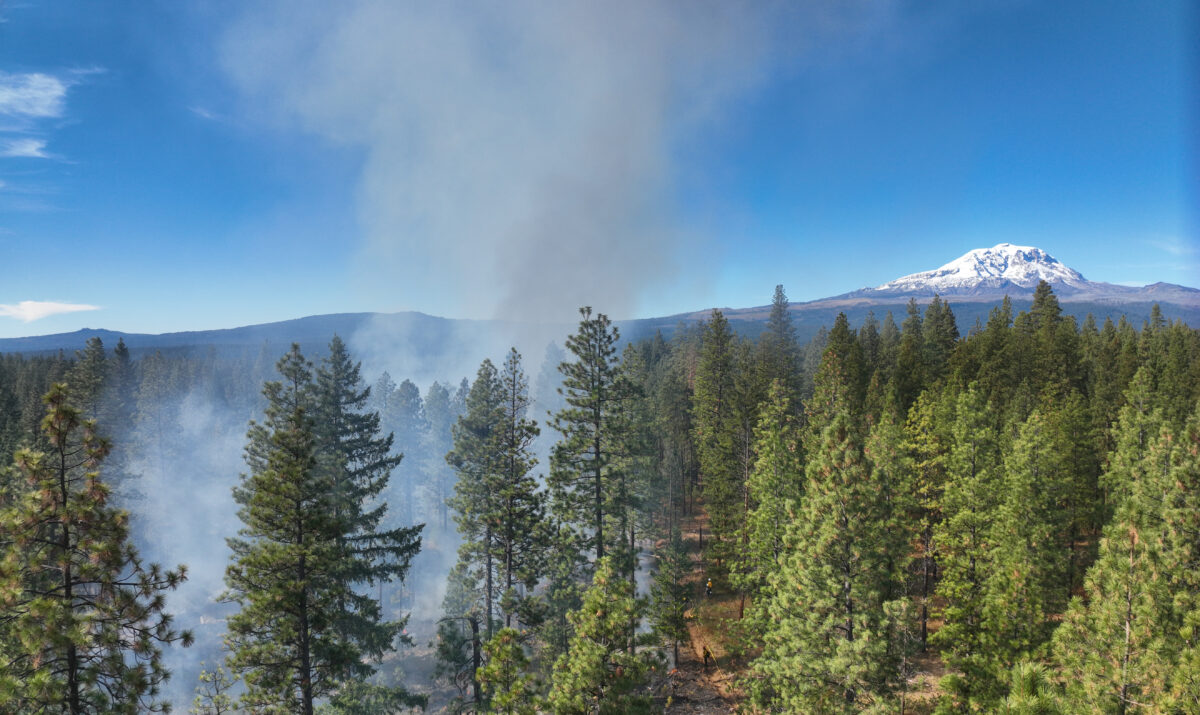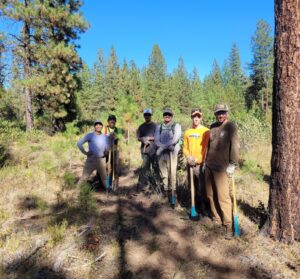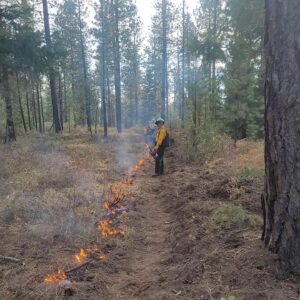Good Fire in the Gorge
A successful prescribed burn on a Land Trust site in the East Cascades, implemented during a TREX training exchange

“As I watched the flames move across the forest floor, I considered all the learning that had brought us to this place and this moment — igniting grasses and needles for the good of the forest. My early training with fire had all been about suppression, Smokey the Bear and all that. Watching this mellow fire burn at my feet, I considered how people had this kind of positive relationship with fire for millennia, knowing and understanding its benefits and role in our ecosystems. Finding our way back to that feels really good.” – Lindsay Cornelius, East Cascades Oak Partnership Manager
This fall Columbia Land Trust staff and a team of partners implemented a successful prescribed burn at our Bear Creek Natural Area in the East Cascades. This marked a major milestone after years of working to thoughtfully incorporate prescribed fire as a stewardship tool to benefit the long-term health and resiliency of lands we manage.
Our ecological goals at Bear Creek are to reduce the number of conifer seedlings, saplings, and woody cover, and to consume litter and duff on the forest floor. Preemptively burning these surface fuels reduces the risk of high intensity fires for several years and gives overstory trees time to mature. It also helps the Land Trust be a good neighbor by reducing the risk of sending high intensity fire onto neighboring lands.
“Much of Bear Creek Natural Area is home to approximately 100-year-old Ponderosa pines that we would love to see move into the 200-year-old age class and beyond. Ponderosa pines become more fire resilient as they age,” said Natural Area Manager Adam Lieberg.
The Bear Creek burn took place during the inaugural Columbia Gorge TREX event, hosted by Mount Adams Resource Stewards (MARS).
TREX is an abbreviation for Prescribed Fire Training Exchanges, which have been taking place around the country since 2008, drawing participants from federal, local, state agencies, Tribes, nonprofits, and private organizations. These 14-day intensive training events facilitate peer-to-peer knowledge sharing and hands-on learning related to prescribed fire and fire-adapted landscapes, promoting landscape health and ecosystem resilience.
The Land Trust team participated as part of our efforts to increase organizational capacity to safely, responsibly, and effectively implement prescribed fire, which we view as an important tool in the stewardship and restoration of the lands we manage. This is especially true east of the Cascades, where many of our sites are fire-adapted and require frequent, low-intensity fire to be healthy and resilient.
One of the Land Trust’s overall conservation objectives for the East Cascades ecoregion is to restore natural disturbance regimes, including beneficial fire, to the land and ecosystems we care for, as well as building skills within our staff. Safety is, of course, paramount.
Utilizing prescribed fire is also aligned with the Land Trust’s focus on natural climate solutions, as the carbon emissions resulting from a catastrophic wildfire are significantly greater and more damaging than the emissions from a controlled burn. Prescribed fire has in fact been found to reduce carbon fire emissions across the Western United States when applied at scale.1

More than 30 individuals representing nearly a dozen organizations and agencies participated in Columbia Gorge TREX. Activities included studying local ecology, equipment training and practice, site visits, educational workshops, and landscape restoration projects-such as prescribed burning. One of the goals of TREX is to make prescribed fire implementation and knowledge more inclusive and accessible, and attendees came with a wide range of experience, from full-time professional firefighters and burn bosses to non-agency organizations and staff looking for their first burn experience.
“TREX is a great opportunity to learn new skills and to strengthen partnerships,” said Land Trust Natural Area Manager Adam Lieberg.
Damp fall weather created challenging conditions for putting beneficial fire on the ground, but the group managed to assist with pile burning2 efforts at the Conboy Lake National Wildlife Refuge, the Columbia River Gorge National Scenic Area, and newly acquired lands owned and managed by MARS.
In the second week the weather dried out a bit, allowing the group to complete two broadcast burns,2 one at Bear Creek and another at Mt. Adams Community Forest site.
“Finding the right weather window is one of the most challenging aspects of applying prescribed fire,” said Cornelius. “After a summer of waiting nervously, hoping a catastrophic fire won’t break out, when it finally is safe to implement prescribed burning, you often find it’s now too wet!”
The Land Trust site targeted for the broadcast burn was a 47-acre unit within our 3,900-acre Bear Creek Natural Area, conserved in 2021. Located near Mt. Adams and the upper reaches of the Klickitat River, Bear Creek links conserved lands on the Yakama Nation Indian Reservation with lands managed by the Washington Department of Fish and Wildlife and Department of Natural Resources, to create an expansive corridor protecting important wildlife habitat and migration routes.
This prescribed burn was the culmination of months of preparation, which included the creation of a comprehensive burn plan–a document outlining the burn location, communication and notification strategies, a list of required equipment and resources, a safety plan, burn objectives, weather parameters, mop-up standards, and more.
“You spend months planning, and then for the burn to happen you still need a bit of luck. Threading the needle between waiting for burn bans to be lifted and having fuels still available to burn can be challenging. As a result, our burn windows are often unpredictable and fleeting,” said Lieberg.
Implementing prescribed fire safely is a balancing act, as a certain minimum intensity is required to accomplish our ecological goals. For example, some mortality of overstory trees is expected and planned for, but we did not want to kill more than 10% of the overstory.
The burn itself lasted only an afternoon, transforming the landscape in a matter of hours.

During the burn, Land Trust staff held multiple roles, including participating in ignition operations, monitoring control lines, and working with the burn boss. “It was rewarding to see such a variety of participation, and watch all the pieces come together,” said Lieberg.
Afterwards, Land Trust staff continued to closely monitor the site until three days in a row elapsed without any heat or smoke detected.
“Despite the weather and environmental parameters being on the wetter end for our desired fire behavior, this was our first entry burn and we are really pleased with the results thus far,” said Lieberg. “One of the reasons we selected this location is because it is representative of an additional 2,000 acres in similar condition that we think could benefit from prescribed fire. We now have a 47-acre anchor point from which to build future burns, plus a lot of valuable experience and important lessons learned.”
Collaboration is essential to projects like this, and Columbia Land Trust could not have implemented this burn without our many partners and fellow TREX attendees.
Columbia Land Trust, MARS, Sustainable Northwest, and other regional organizations are in the process of forming a Prescribed Burn Association, which held its first public meeting in early December 2023. To find out more about the South Mount Adams PBA, contact Adam Lieberg at Columbia Land Trust (alieberg@columbialandtrust.org) or Sarah Allaben at Mt. Adams Resource Stewards (sarah@mtadamsstewards.org).
This is the third piece in our series on prescribed fire. You can read our previous posts here:
1 https://www.naturebasedsolutionsinitiative.org/publications/prescribed-fire-as-a-means-of-reducing-forest-carbon-emissions-in-the-western-united-states
2 Pile burning and broadcast burning are two different methods of prescribed fire used to manage and restore working forests. Pile burning involves the burning of small woody debris that is often generated after tree thinning or commercial harvest activities and then collected into piles. This method is often used to reduce the amount of fuel available for wildfires. Broadcast burning involves the intentional burning of existing live and dead vegetation over a large area. This method is aimed at achieving specific ecological objectives, such as restoring fire-adapted ecosystems and/or promoting certain wildlife habitats.